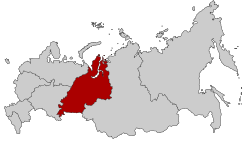Ural Federal District
|
Ural Federal District Уральский федеральный округ |
|
|---|---|
| Federal district of Russia | |
 Location of the Ural Federal District within Russia |
|
| Country |
|
| Established | May 18, 2000 |
| Administrative center | Yekaterinburg |
| Government | |
| • Presidential Envoy | Igor Kholmanskikh |
| Area | |
| • Total | 1,818,500 km2 (702,100 sq mi) |
| Area rank | 3rd |
| Population (2010) | |
| • Total | 12,080,526 |
| • Rank | 6th |
| • Density | 6.75/km2 (17.5/sq mi) |
| • Urban | 79.9% |
| • Rural | 20.1% |
| Federal subjects | 6 contained |
| Economic regions | 2 contained |
| Website | www |
Coordinates: 56°50′N 60°35′E / 56.833°N 60.583°E
Ural Federal District (Russian: Ура́льский федера́льный о́круг, Uralsky federalny okrug) is one of the eight federal districts of Russia. Its population was 12,080,523 (79.9% urban) according to the 2010 Census.
The district was established on May 13, 2000 by a decree of the President of Russia. It is located at the border of the European and Asian parts of Russia. The administrative center of the district is the city of Yekaterinburg.
The district contributes 18% to Russia’s Gross Regional Product (GRP), although its population is only 8.5% of the Russian total.
The district covers an area of 1,818,500 square kilometers (702,100 sq mi), about 10% of Russia. According to the 2010 Census, the district had a population of 12,080,526, of whom 82.74% were Russians (10,237,992 people), 5.14% Tatars (636,454), 2.87% Ukrainians (355,087) and 2.15% Bashkirs (265,586). The remainder comprises various ethnicities of the former Soviet Union. 79.9% of the district's population lived in urban areas.
In 2006, the district provided 90% of Russian natural gas production, 68% of oil and 42% of metal products. Industrial production per capita in the district is about 2.5 times higher than the average value throughout Russia. The district provides about 42% of Russian tax incomes, mostly from industry. Its major branches are fuel mining and production (53%), metallurgy (24%) and metal processing and engineering (8.8%). The latter two are especially developed in Chelyabinsk and Sverdlovsk Oblast which, between them, constitute 83% of Russian metallurgy and 73% of metal processing and engineering. Whereas fuel and mineral mining has been providing a nearly constant outcome between 1990 and 2006, metal processing and engineering are declining, despite the fact that they employ up to 30% of industry workers of the district. Local ore processing plants can provide only 20% of required copper, 28% chromium, 35% iron and 17% coal, and many of these resources are nearly exhausted. Meanwhile, the average distance to import them to the Ural is 2,500 km.
...
Wikipedia
